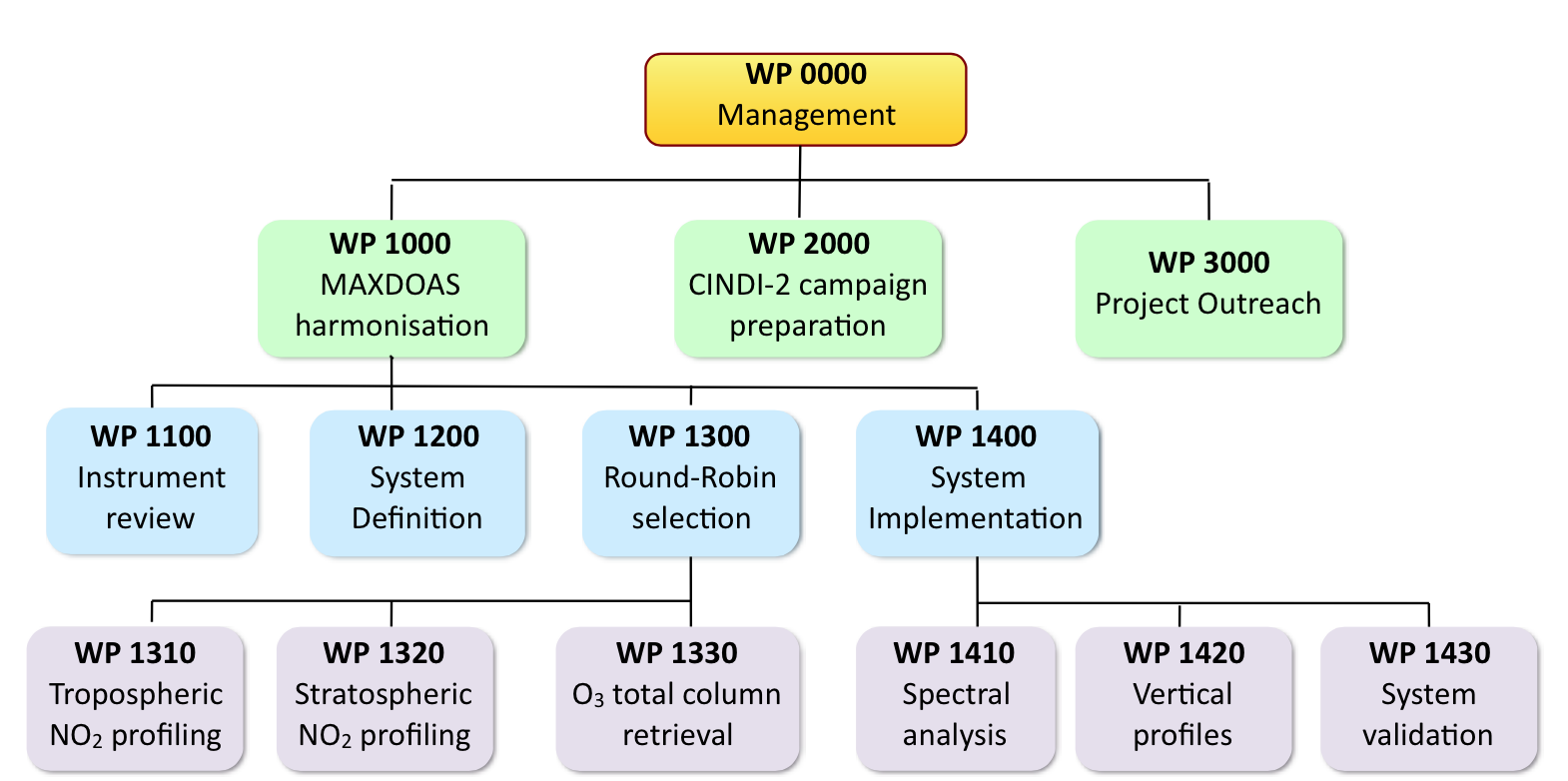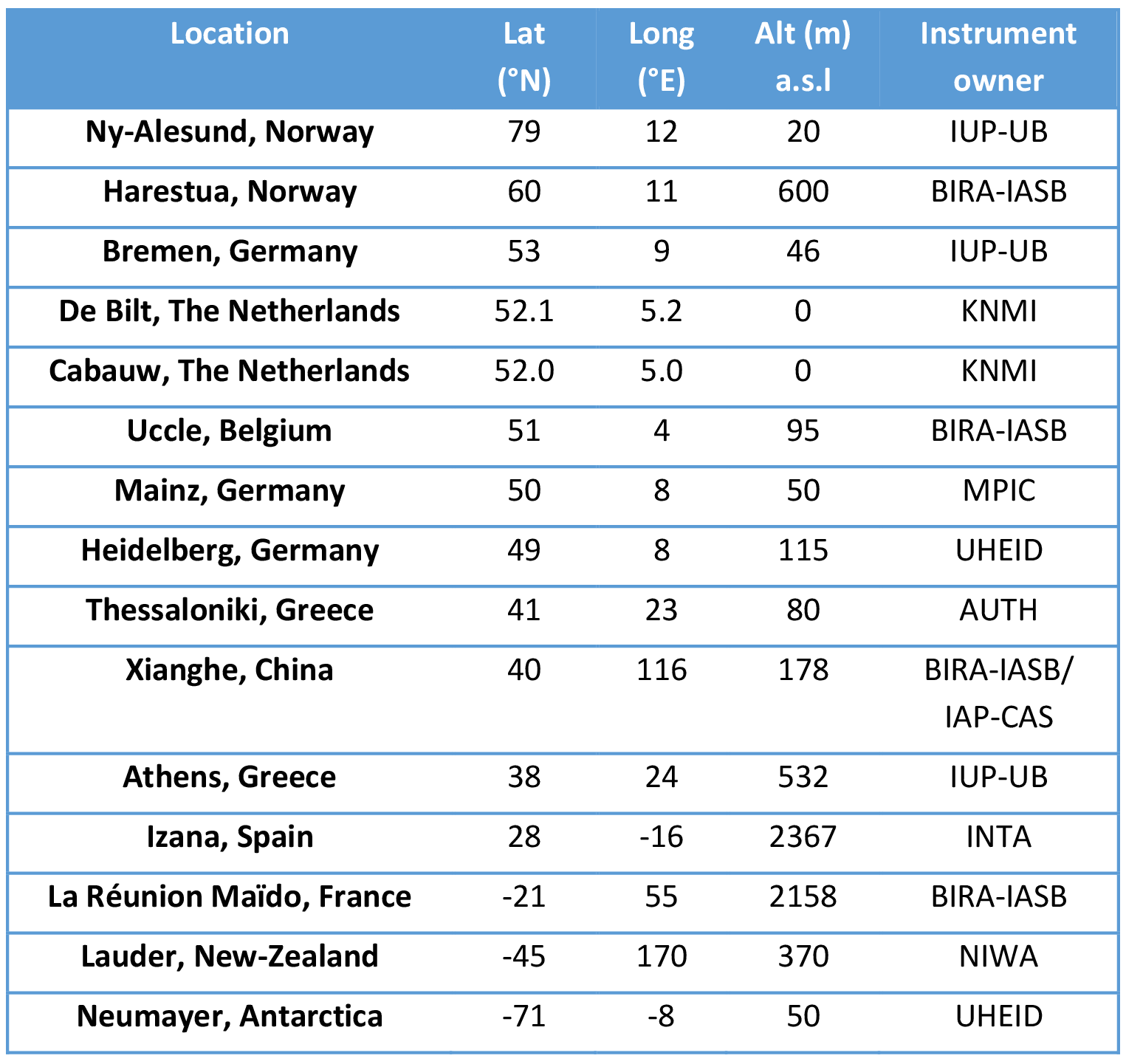The FRM4DOAS Phase I project (July 2016 - August 2021) consists of three main technical work packages: WP 1000 (MAXDOAS Harmonisation), WP 2000 (CINDI-2 Campaign Preparation), and WP 3000 (Project Outreach).

The most intensive part of the project will take place within WP 1000 which consists in the design, building, and demonstration of an automated and harmonized MAXDOAS processing system providing Air-Quality FRM data. Four main sub-activities are planned: WP 1100 (Network Instrument Review), WP 1200 (Processing System Definition), WP 1300 (Round-Robin Algorithm Selection), and WP 1400 (Processing System Implemantation).

The starting point (WP 1100) consists in a review of the current status of MAX-DOAS instruments and networks, including technological design, scientific quality, reliability, calibration status, documentation, data processing and data availability, peer-reviewed publications. This also includes the definition of the technical requirements for an operational MAX-DOAS processing system addressing all necessary issues, i.e. I/O, processing performance, QA/QC, data formatting, etc. The output of this work package is the subject of three project deliverables: MAX-DOAS Instruments Review Document, MAX-DOAS Network Scientific Requirements Document, and the MAX-DOAS Calibration and Operations Best Practices.
In a second step, the processing system architecture has been defined as part of WP 1200. Essential requirements that have been considered are modularity and scalability as well as QA/QC procedures. The corresponding deliverables are the MAX-DOAS Network Processing System Technical Requirements Document and the MAX-DOAS Network Processing System Architecture Design Document.
In order to select a baseline set of retrieval algorithms to be implemented in the system, a Round-Robin intercomparison exercise involving all key actors in MAX-DOAS research in Europe has been organised as part of WP 1300. This activity focused on tropospheric NO2 vertical profiling (WP 1310), stratospheric NO2 vertical profiling (WP 1320), and O3 total column retrievals (WP 1330). It should be noted that the NO2 vertical profiling algorithm selected as baseline for implementation in the FRM4DOAS will be transferred to the optional HCHO retrieval without any further performance assessment and/or optimization. The Round-Robin exercise used the heritage from the related past projects GEOMON and NORS as well as the synergy with ongoing activities in the EU QA4ECV project. The output of this WP is the selection of baseline algorithms ready for implementation in the processing system. Main deliverables are the Round-Robin Definition and Results Document and the ATBD for the selected retrieval algorithm.
In a next step, the central processing system is implemented within WP 1400. The main task is the development of the operational processing code which includes modules for DOAS spectral analysis (WP 1410), trace gas vertical profiling (WP 1420), and processing system validation (WP 1430). In order to ensure adequate modularity and scalability, the trace gas vertical profiling processor is divided into three separate modules for tropospheric and stratospheric NO2 vertical profile retrievals and total column ozone retrieval. All these processing elements are documented in the MAX-DOAS Network Processing System Software Package. The final step in WP 1400 was to evaluate the performance of the system, to test it on actual measurement data (WP 1430) and to document the results in the MAX-DOAS Network Processing System Evaluation and Demonstration report. In order to allow easy access to the proceeded data, a data download web page is made available from the present project web site.
The demonstration of the processing system is based on a selection of instruments and sites available from project partners. The sites planned for integration are listed in the table below. Calibrated radiance spectra from each of these stations data are delivered on a daily basis to the central processing system, according to a common standardized radiance file format and generally following a Protocol for Instrument Operation that has been defined as part of the project. All necessary ancillary information, such as slit function, spectral range can be included in the file as metadata. In addition to these reference sites, the central system has been tested on spectra from a large number of instruments gathered from the CINDI-2 intercomparison campaign.

In parallel to the development of the processing system which will be the main task in this project, some resources have been also dedicated in WP 2000 to the preparation and planning of the CINDI-2 campaign which was held in September 2016 in Cabauw (The Netherlands). This campaign was a follow-up of the successful CINDI campaign (Piters et al., 2012) and focused on the Intercalibration of a large number of DOAS and MAXDOAS system in view of their contribution to the validation of air quality satellite sensors (in particular the Sentinels 4, 5 and 5P). Preparation tasks included the writing of planning documents and scientific coordination with the local organiser of the campaign KNMI.
Finally the last task of the project (WP 3000) consisted in setting up a web story on the ESA web portal presenting and illustrating the work undertaken in the project in view of harmonizing MAXDOAS network measurements in support of the Cal/Val of future atmospheric Sentinel missions.
